Numerical Assessment of Earth to Air Heat Exchanger with Variable Humidity Conditions in Greenhouses
Abstract
:1. Introduction
2. Materials and Methods
- (1)
- The water film flow in the multi-pipe EAHE was continuous;
- (2)
- The condition of the water film forming a small flow was not considered;
- (3)
- The breaking and splashing process of the droplet was ignored;
- (4)
- The wet air contains air and water vapor, which was assumed as an incompressible ideal gas. It conformed to the ideal gas mixing law.
3. Evaluation Index
3.1. Airflow Division Uniformity Coefficient
3.2. Temperature Extraction Efficiency
3.3. Integrated Evaluation Factor
4. Results and Discussion
4.1. Uniformity of RH in EAHE
4.2. The Effect of Inlet Air RH on the Thermal Performance of EAHE
4.3. The Effect of Inlet Air Temperature and Volume Flow Rate on the Thermal Performance of EAHE
4.4. The Effect of Structure on Condensation in EAHE
5. Conclusions
- The uniformity performance of the RH in each parallel pipe deteriorated with the increase in the RH inlet air. The condensation phenomenon occurred easily in the last pipe from the perspective of the flow direction, when the earth to air heat exchanger was the U-type structure.
- The condensation had few effects on the airflow distribution uniformity of the EAHE. However, it had a significant effect on the thermal performance of the EAHE. The integrated performance of the EAHE declined by 7.9% when the wet air condensed in the pipes.
- The higher inlet air temperature and volume flow rate resulted in more non-uniform distributions of RH. Thus, the possibility of condensation increased.
- When the diameter of the main pipe was constant, decreasing the diameter of the parallel pipe would decrease the integrated performance of the EAHE by 44% and increase the amount of condensation water. Considering the integrated performance and the distribution of condensation water, the performance of the Z-type structure EAHE was worst. The integrated performance of the L-type structure EAHE was optimal.
Author Contributions
Funding
Conflicts of Interest
Nomenclature
| EAHE | Earth to air heat exchanger |
| RH | Relativity humidity |
| hf | Film height |
| Mean film velocity | |
| ρl | Liquid density |
| The surface gradient operator | |
| The mass source per unit wall area | |
| PL | Pressure of air on the wall |
| The component of gravity parallel to the wall | |
| Shear stress at gas-liquid interface | |
| The kinematic viscosity of the water film | |
| Pressure change caused by the water droplets or the separation of water film | |
| cp | Specific heat capacity |
| Source term due to liquid impingement from the bulk flow to the wall | |
| Average film temperature | |
| Film surface temperature | |
| Wall temperature | |
| Thermal conductivity of wall film | |
| Latent heat associated with the phase change | |
| Mass vaporization or condensation rate | |
| Ω | Airflow division uniformity coefficient |
| The volume flow rate in each pipe of EAHE | |
| The average volume flow rate | |
| n | Number of parallel pipes |
| θ | The temperature extraction efficiency |
| Tout | The outlet temperature of EAHE |
| Tin | The inlet temperature of EAHE |
| Tsoil | The soil temperature in the far-field |
| η | The integrated evaluation factor |
| f | Friction factor |
| Δp | The pressure drop between the inlet and outlet |
| ρf | The density of air |
| uf | Velocity of air |
| h | Overall heat transfer coefficient of EAHE |
| Q | Heat transfer rate |
| m | Mass flow rate |
| Hin | The enthalpy of the inlet air |
| Hout | The enthalpy of the outlet air |
| ΔTm | Logarithmic mean temperature differences between soil and air |
References
- Akeiber, H.; Nejat, P.; Majid, M.Z.A.; Wahid, M.A.; Jomehzadeh, F.; Famileh, I.Z.; Calautit, J.K.; Hughes, B.R.; Zaki, S.A. A review on phase change material (PCM) for sustainable passive cooling in building envelopes. Renew. Sustain. Energy Rev. 2016, 60, 1470–1497. [Google Scholar] [CrossRef]
- Yin, X.; Cao, F.; Wang, J.; Li, M.; Wang, X. Investigations on optimal discharge pressure in CO2 heat pumps using the GMDH and PSO-BP type neural network—Part A: Theoretical modeling. Int. J. Refrig. 2019, 106, 549–557. [Google Scholar] [CrossRef]
- Qi, D.; Pu, L.; Ma, Z.; Xia, L.; Li, Y. Effects of ground heat exchangers with different connection configurations on the heating performance of GSHP systems. Geothermics 2019, 80, 20–30. [Google Scholar] [CrossRef]
- Dabaieh, M.; Serageldin, A.A. Earth air heat exchanger, Trombe wall and green wall for passive heating and cooling in premium passive refugee house in Sweden. Energy Convers. Manag. 2020, 209, 112555. [Google Scholar] [CrossRef]
- Congedo, P.M.; Baglivo, C.; Bonuso, S.; D’Agostino, D. Numerical and experimental analysis of the energy performance of an air-source heat pump (ASHP) coupled with a horizontal earth-to-air heat exchanger (EAHX) in different climates. Geothermics 2020, 87, 101845. [Google Scholar] [CrossRef]
- Bonuso, S.; Panico, S.; Baglivo, C.; Mazzeo, D.; Matera, N.; Congedo, P.M.; Oliveti, G. Dynamic analysis of the natural and mechanical ventilation of a solar greenhouse by coupling Controlled Mechanical Ventilation (CMV) with an Earth-to-Air Heat Exchanger (EAHX). Energies 2020, 13, 3676. [Google Scholar] [CrossRef]
- Gomat, L.J.P.; Motoula, S.M.E.; M’Passi-Mabiala, B. An analytical method to evaluate the impact of vertical part of an earth-air heat exchanger on the whole system. Renew. Energy 2020, 162, 1005–1016. [Google Scholar] [CrossRef]
- Lekhal, M.C.; Benzaama, M.H.; Kindinis, A.; Mokhtari, A.M.; Belarbi, R. Effect of geo-climatic conditions and pipe material on heating performance of earth-air heat exchangers. Renew. Energy 2021, 163, 22–40. [Google Scholar] [CrossRef]
- Zajch, A.; Gough, W.A. Seasonal sensitivity to atmospheric and ground surface temperature changes of an open earth-air heat exchanger in Canadian climates. Geothermics 2021, 89, 101914. [Google Scholar] [CrossRef]
- Zajch, A.; Gough, W.A.; Yoon, G. Influence of daily temperature behavior on earth-air heat exchangers: A case study from Aichi, Japan. City Environ. Interact. 2020, 8, 100054. [Google Scholar] [CrossRef]
- D’Agostino, D.; Esposito, F.; Greco, A.; Masselli, C.; Minichiello, F. Parametric analysis on an Earth-to-Air Heat exchanger employed in an air conditioning system. Energies 2020, 13, 2925. [Google Scholar] [CrossRef]
- D’Agostino, D.; Greco, A.; Masselli, C.; Minichiello, F. The employment of an earth-to-air heat exchanger as pre-treating unit of an air conditioning system for energy saving: A comparison among different worldwide climatic zones. Energy Build. 2020, 229, 110517. [Google Scholar] [CrossRef] [PubMed]
- Rosa, N.; Soares, N.; Costa, J.; Santos, P.; Gervásio, H. Assessment of an earth-air heat exchanger (EAHE) system for residential buildings in warm-summer Mediterranean climate. Sustain. Energy Technol. Assess. 2020, 38, 100649. [Google Scholar] [CrossRef]
- Chiesa, G.; Zajch, A. Contrasting climate-based approaches and building simulations for the investigation of Earth-to-air Heat Exchanger (EAHE) cooling sensitivity to building dimensions and future climate scenarios in North America. Energy Build. 2020, 227, 110410. [Google Scholar] [CrossRef]
- Li, K.; Xue, W.; Mao, H.; Chen, X.; Jiang, H.; Tan, G. Optimizing the 3d distributed climate inside greenhouses using multi-objective optimization algorithms and computer fluid dynamics. Energies 2019, 12, 2873. [Google Scholar] [CrossRef] [Green Version]
- Guo, J.; Liu, Y.; Lü, E. Numerical simulation of temperature decrease in greenhouses with summer water-sprinkling roof. Energies 2019, 12, 2435. [Google Scholar] [CrossRef] [Green Version]
- Ghoulem, M.; El Moueddeb, K.; Nehdi, E.; Zhong, F.; Calautit, J. Design of a Passive Downdraught Evaporative Cooling Windcatcher (PDEC-WC) system for greenhouses in hot climates. Energies 2020, 13, 2934. [Google Scholar] [CrossRef]
- Sakhri, N.; Menni, Y.; Ameur, H. Experimental investigation of the performance of earth-to-air heat exchangers in arid en-vironments. J. Arid Environ. 2020, 180, 104215. [Google Scholar] [CrossRef]
- Wei, H.; Yang, D.; Wang, J.; Du, J. Field experiments on the cooling capability of earth-to-air heat exchangers in hot and humid climate. Appl. Energy 2020, 276, 115493. [Google Scholar] [CrossRef]
- Cucumo, M.; Cucumo, S.; Montoro, L.; Vulcano, A. A one-dimensional transient analytical model for earth-to-air heat exchangers, taking into account condensation phenomena and thermal perturbation from the upper free surface as well as around the buried pipes. Int. J. Heat Mass Transf. 2008, 51, 506–516. [Google Scholar] [CrossRef]
- Chardome, G.; Feldheim, V. Heat transfer and condensation in an earth-air heat exchanger: 2D/3D numerical modeling validated by experimental measurements. Energy Build. 2019, 205, 109532. [Google Scholar] [CrossRef]
- Niu, F.; Yu, Y.; Yu, D.; Li, H. Heat and mass transfer performance analysis and cooling capacity prediction of earth to air heat exchanger. Appl. Energy 2015, 137, 211–221. [Google Scholar] [CrossRef]
- Gan, G. Dynamic interactions between the ground heat exchanger and environments in earth–air tunnel ventilation of buildings. Energy Build. 2014, 85, 12–22. [Google Scholar] [CrossRef] [Green Version]
- Gao, X.; Zhang, Z.; Xiao, Y. Modelling and thermo-hygrometric performance study of an underground chamber with a long vertical earth-air heat exchanger system. Appl. Therm. Eng. 2020, 180, 115773. [Google Scholar] [CrossRef]
- Gao, X.; Qu, Y.; Xiao, Y.; Xiangkui, G.; Yongtong, Q.; Yimin, X. A numerical method for cooling and dehumidifying process of air flowing through a deeply buried underground tunnel with unsaturated condensation model. Appl. Therm. Eng. 2019, 159, 113891. [Google Scholar] [CrossRef]
- Estrada, E.; Labat, M.; Lorente, S.; Rocha, L.A. The impact of latent heat exchanges on the design of earth air heat exchangers. Appl. Therm. Eng. 2018, 129, 306–317. [Google Scholar] [CrossRef]
- Liu, Q.; Du, Z.; Fan, Y. Heat and mass transfer behavior prediction and thermal performance analysis of Earth-to-Air Heat Exchanger by finite volume method. Energies 2018, 11, 1542. [Google Scholar] [CrossRef] [Green Version]
- Greco, A.; Masselli, C. The optimization of the thermal performances of an Earth to Air Heat Exchanger for an air condi-tioning system: A numerical study. Energies 2020, 13, 6414. [Google Scholar] [CrossRef]
- Mongkon, S.; Thepa, S.; Namprakai, P.; Pratinthong, N. Cooling performance assessment of horizontal earth tube system and effect on planting in tropical greenhouse. Energy Convers. Manag. 2014, 78, 225–236. [Google Scholar] [CrossRef]
- Qi, D.; Li, A.; Li, S.; Zhao, C. Comparative analysis of earth to air heat exchanger configurations based on uniformity and thermal performance. Appl. Therm. Eng. 2021, 183, 116152. [Google Scholar] [CrossRef]
- Kepes Rodrigues, M.; da Silva Brum, R.; Vaz, J.; Oliveira Rocha, LA.; Domingues dos Santos, E.; Isoldi, LA. Numerical inves-tigation about the improvement of the thermal potential of an Earth-Air Heat Exchanger (EAHE) employing the Constructal Design method. Renew. Energy 2015, 80, 538–551. [Google Scholar] [CrossRef]
- Zschaeck, G.; Frank, T.; Burns, A. CFD modelling and validation of wall condensation in the presence of non-condensable gases. Nucl. Eng. Des. 2014, 279, 137–146. [Google Scholar] [CrossRef]
- Li, Y.; Guo, T.; Chang, H. Numerical simulation of 3D hot-air anti-icing chamber based on Eulerian wall film model. J. Beijing Univ. Aeronaut. Astronaut. 2018, 44, 959–966. [Google Scholar]
- Amanowicz, L. Influence of geometrical parameters on the flow characteristics of multi-pipe earth-to-air heat exchangers—experimental and CFD investigations. Appl. Energy 2018, 226, 849–861. [Google Scholar] [CrossRef]
- Zhao, Y.; Li, R.; Ji, C.; Huan, C.; Zhang, B.; Liu, L. Parametric study and design of an earth-air heat exchanger using model experiment for memorial heating and cooling. Appl. Therm. Eng. 2019, 148, 838–845. [Google Scholar] [CrossRef]
- Pu, L.; Qi, D.; Li, K.; Tan, H.; Li, Y. Simulation study on the thermal performance of vertical U-tube heat exchangers for ground source heat pump system. Appl. Therm. Eng. 2015, 79, 202–213. [Google Scholar] [CrossRef]


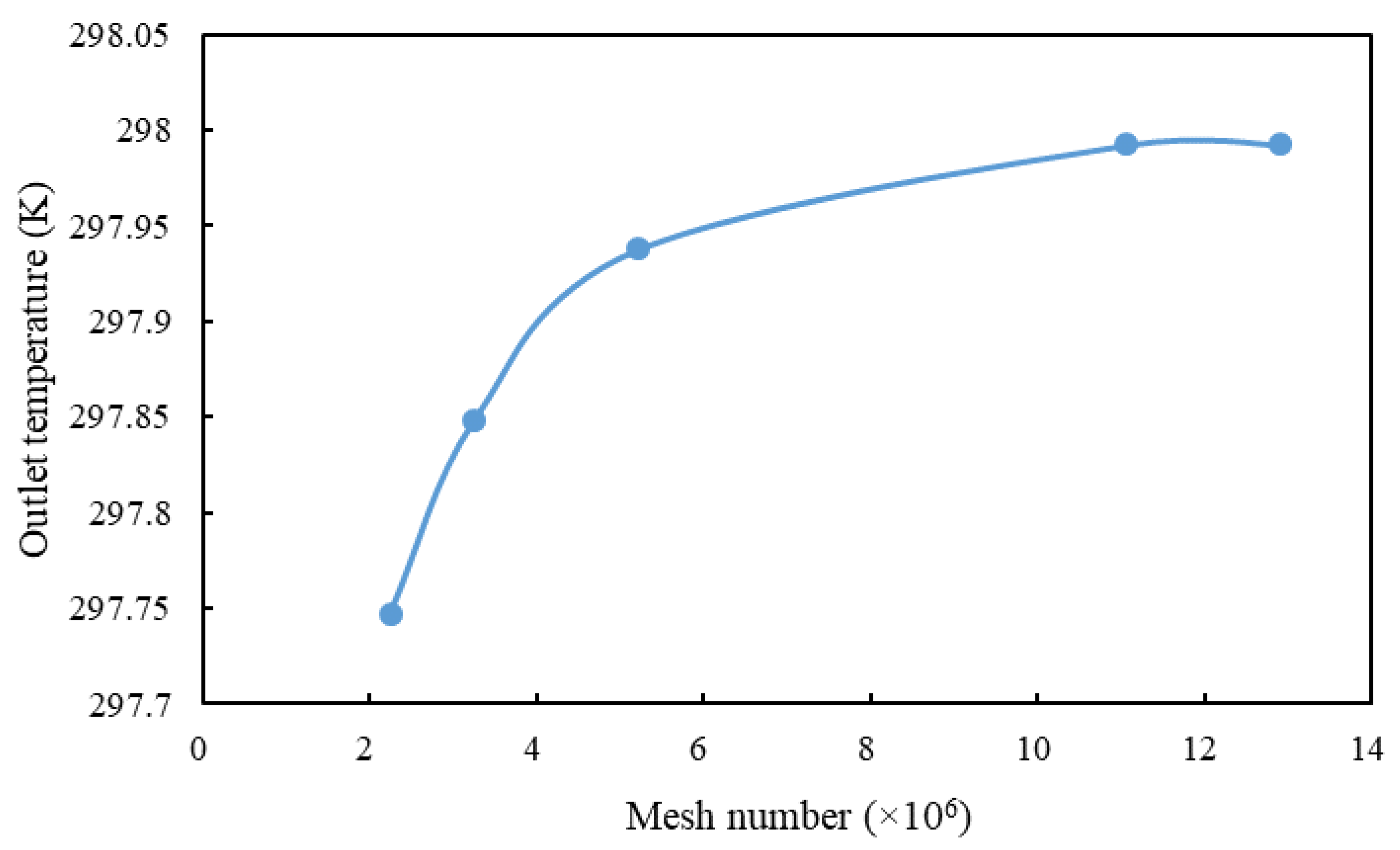
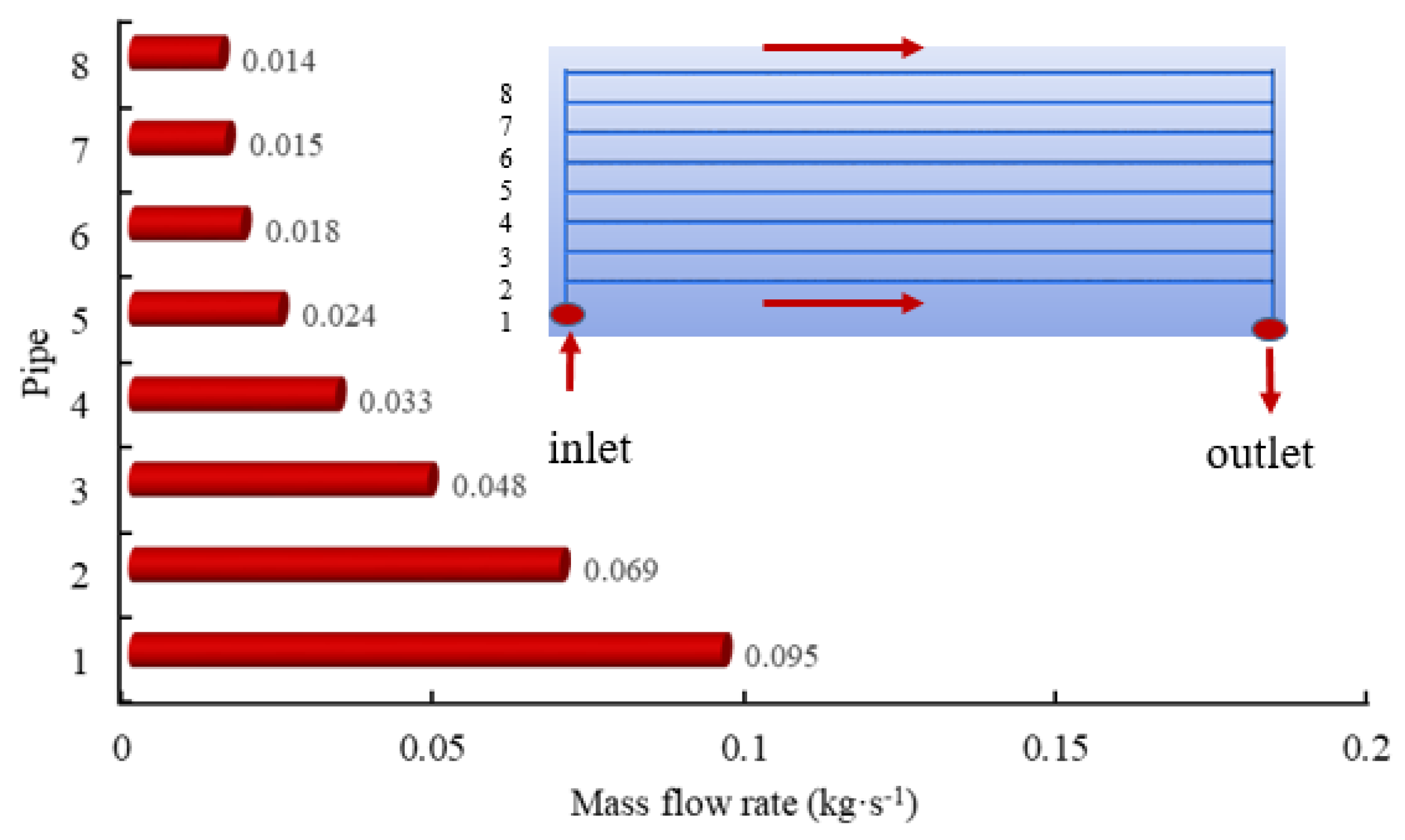


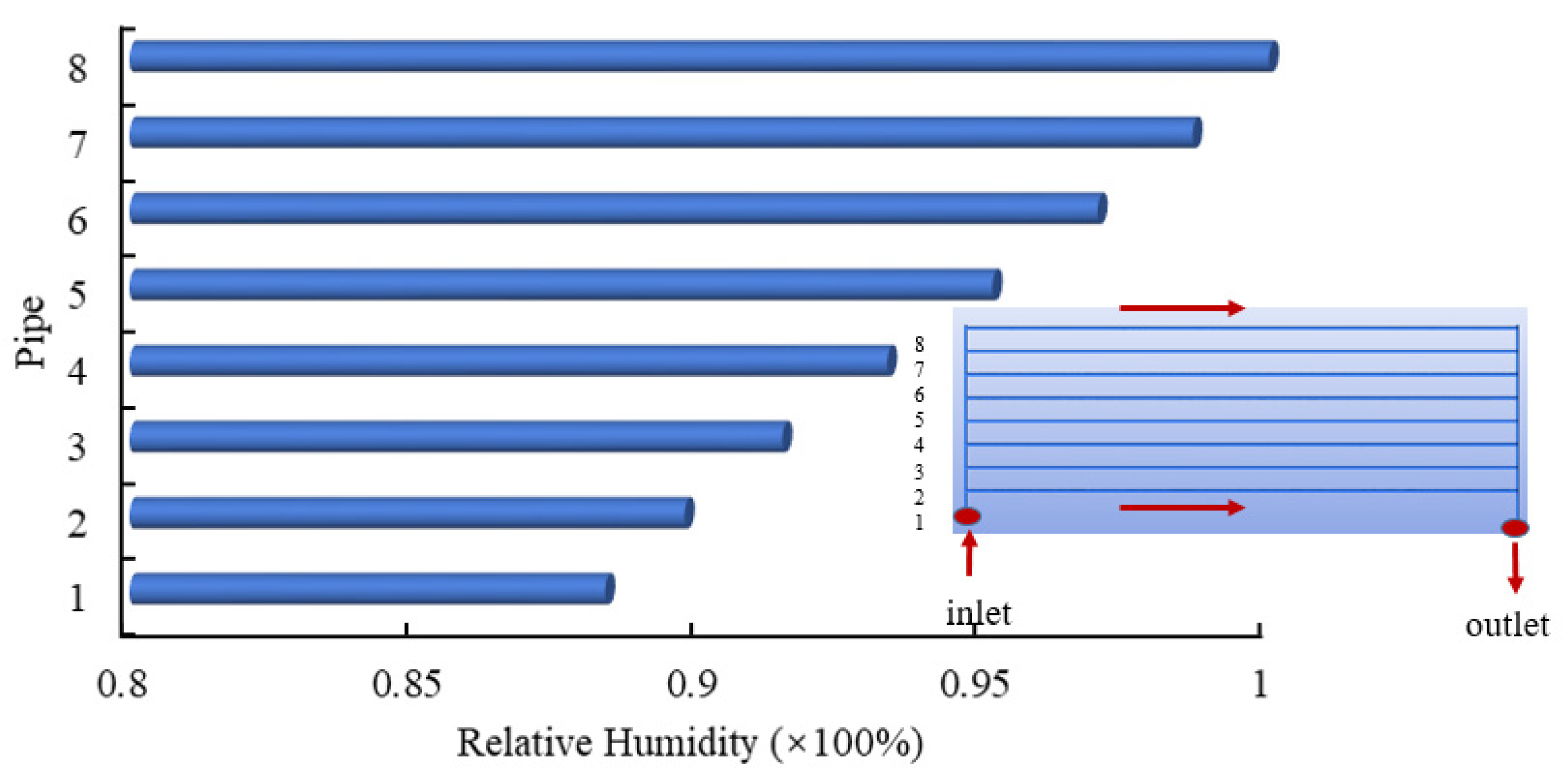
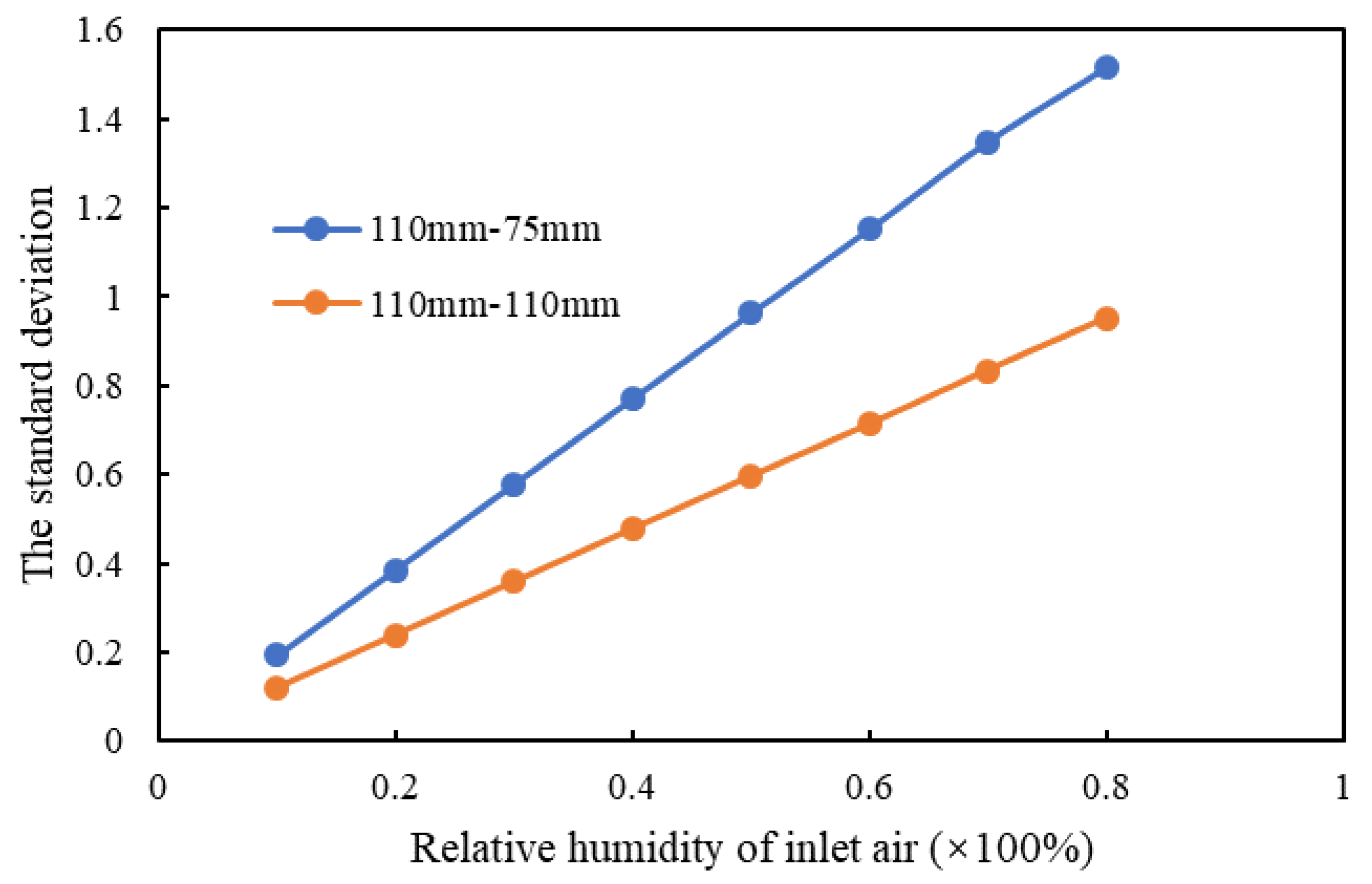
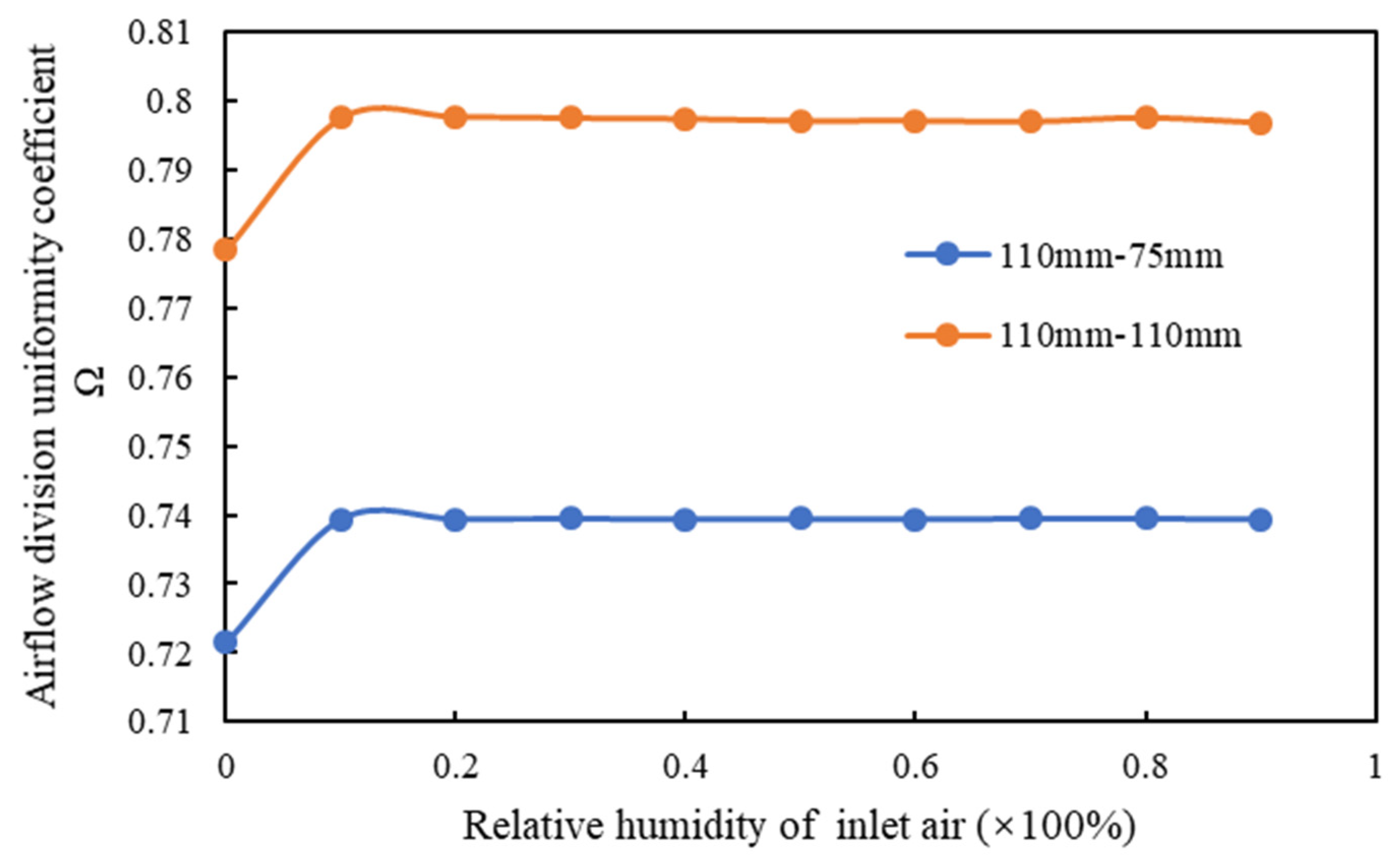


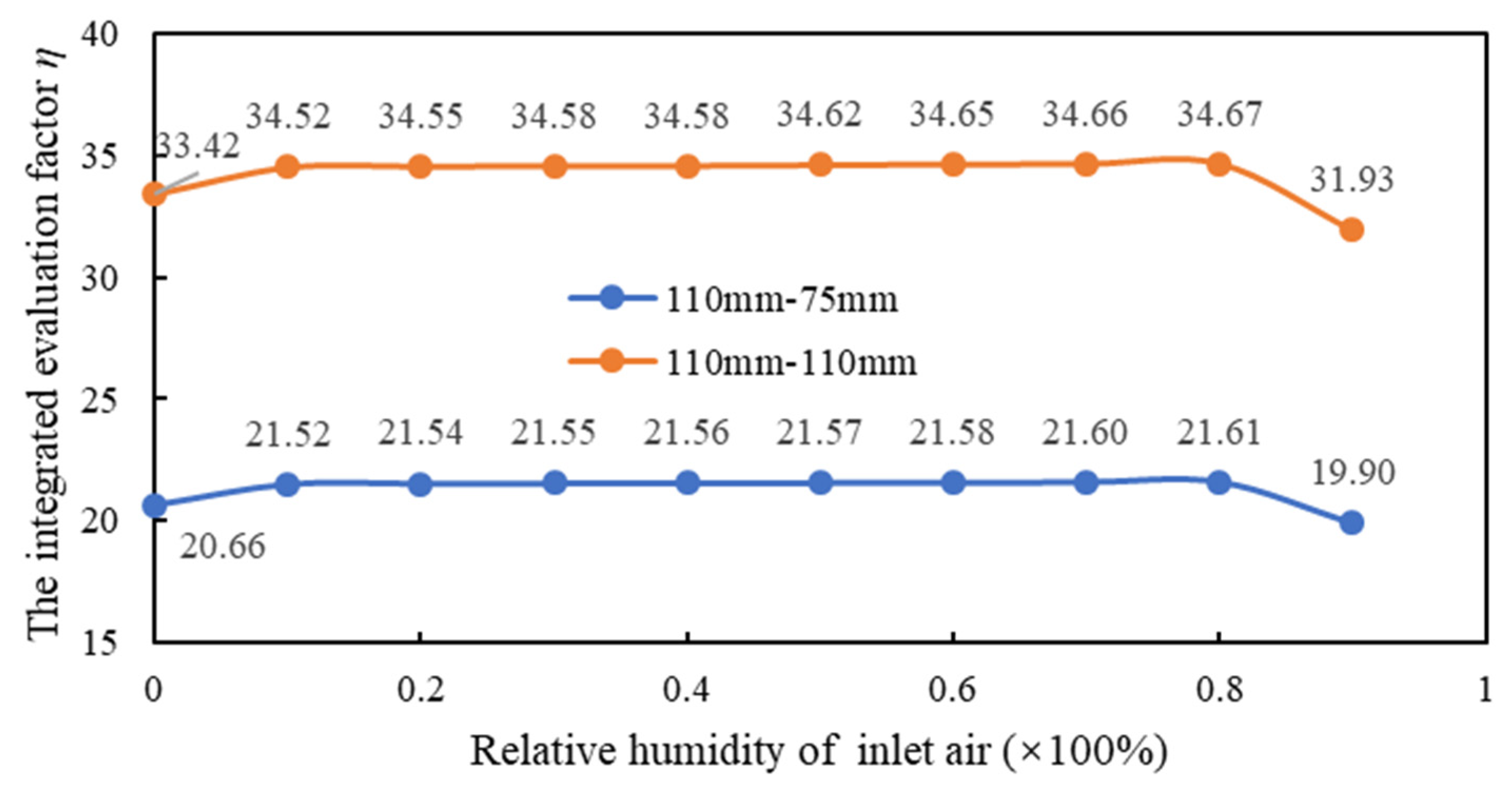


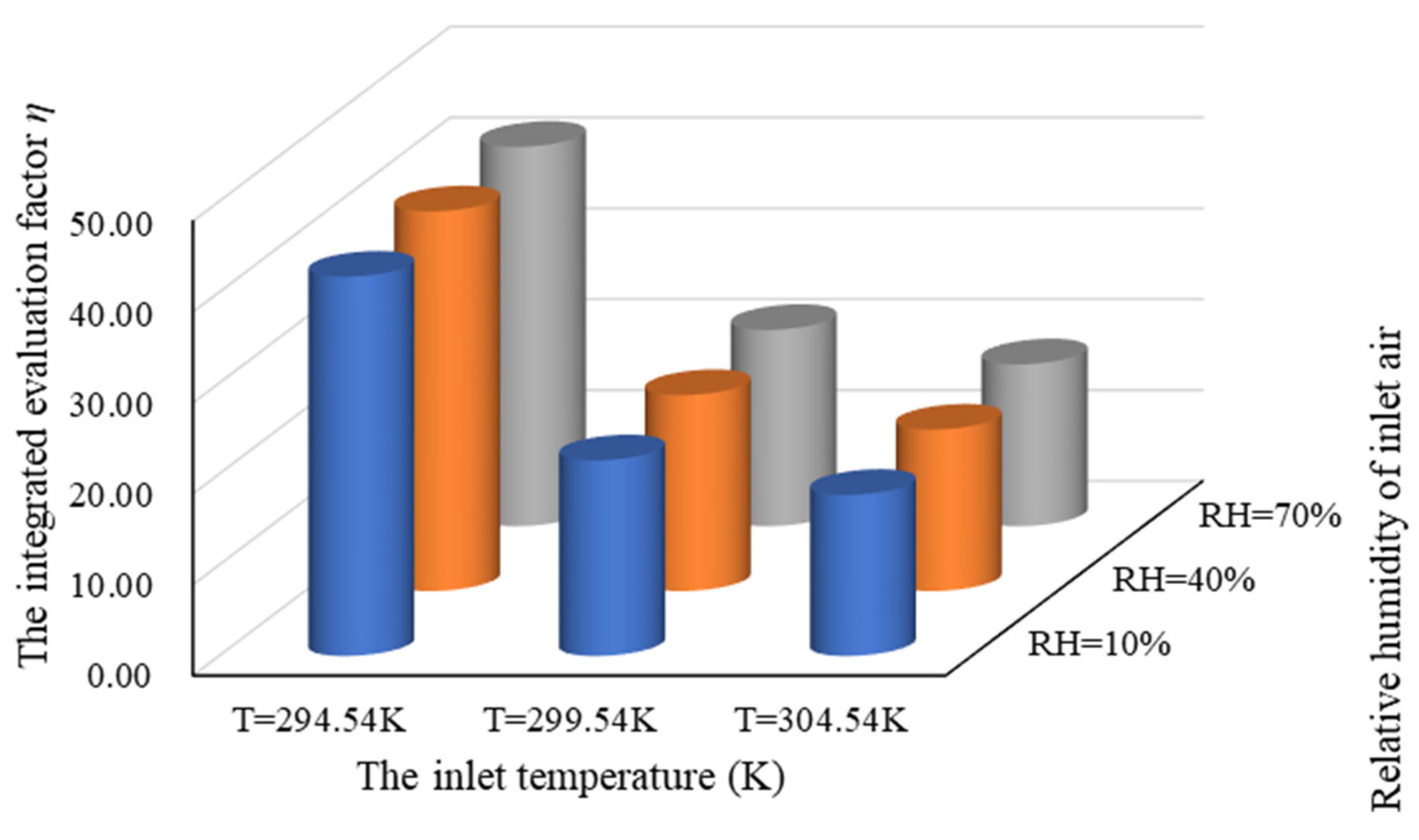
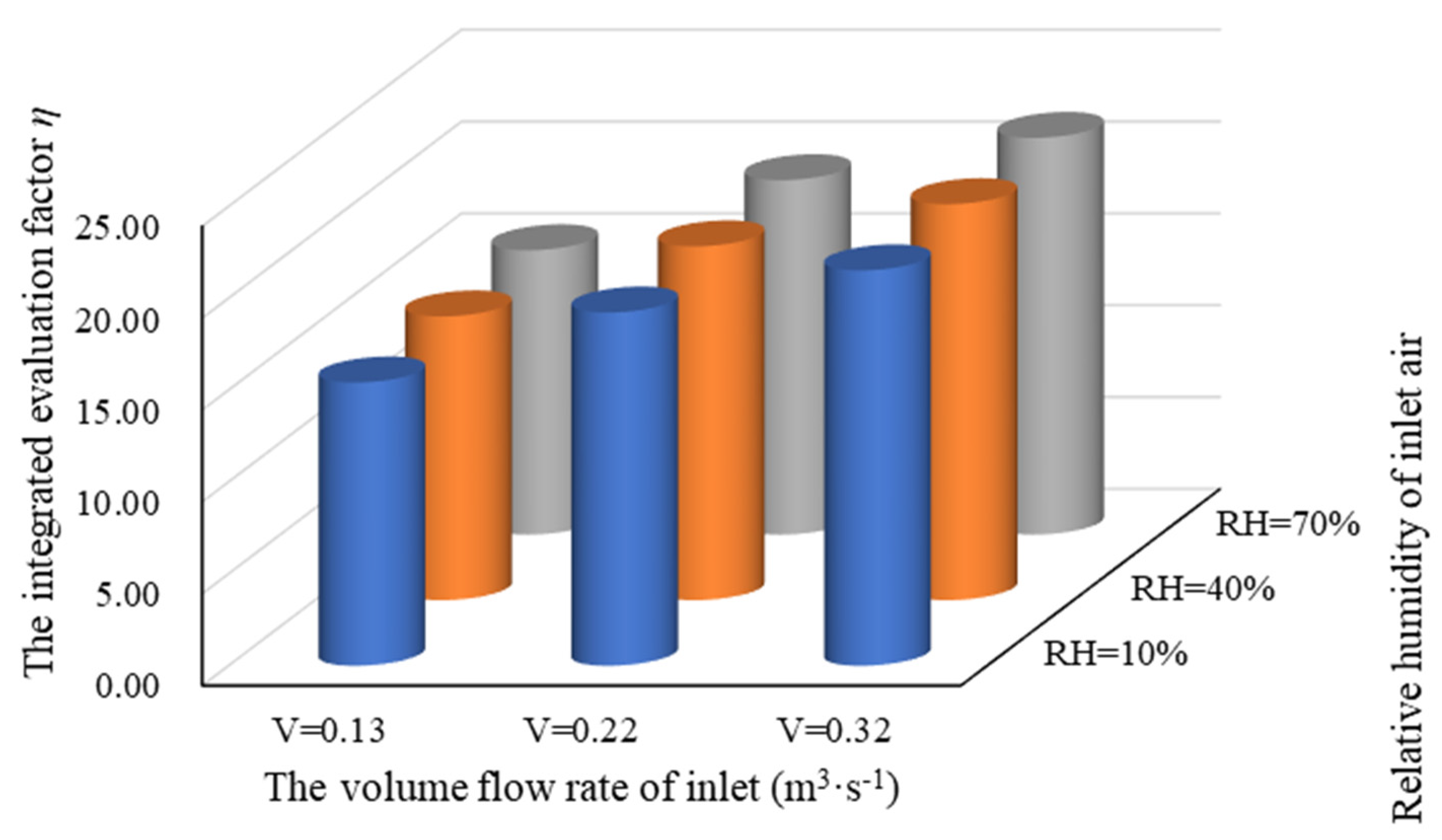
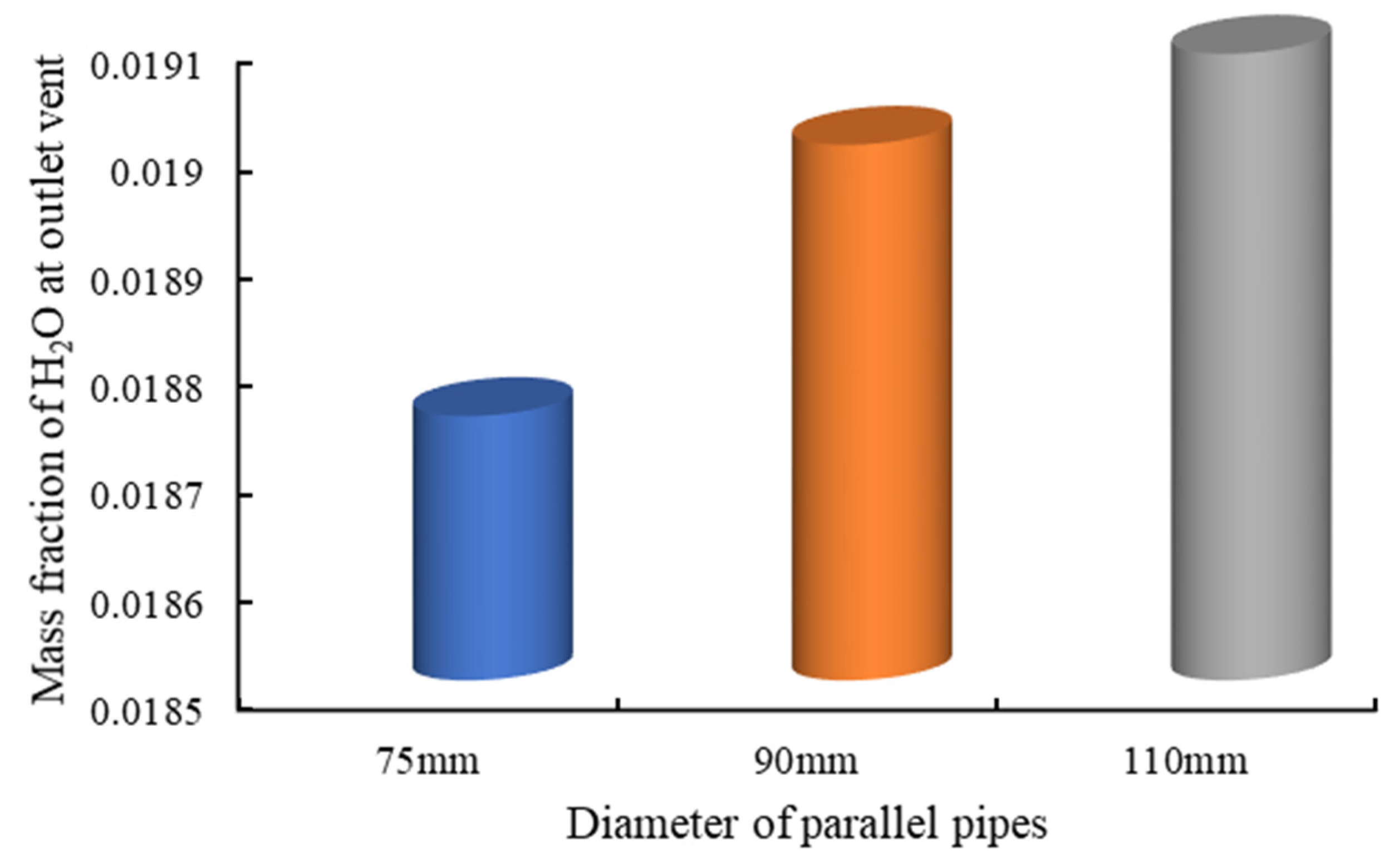
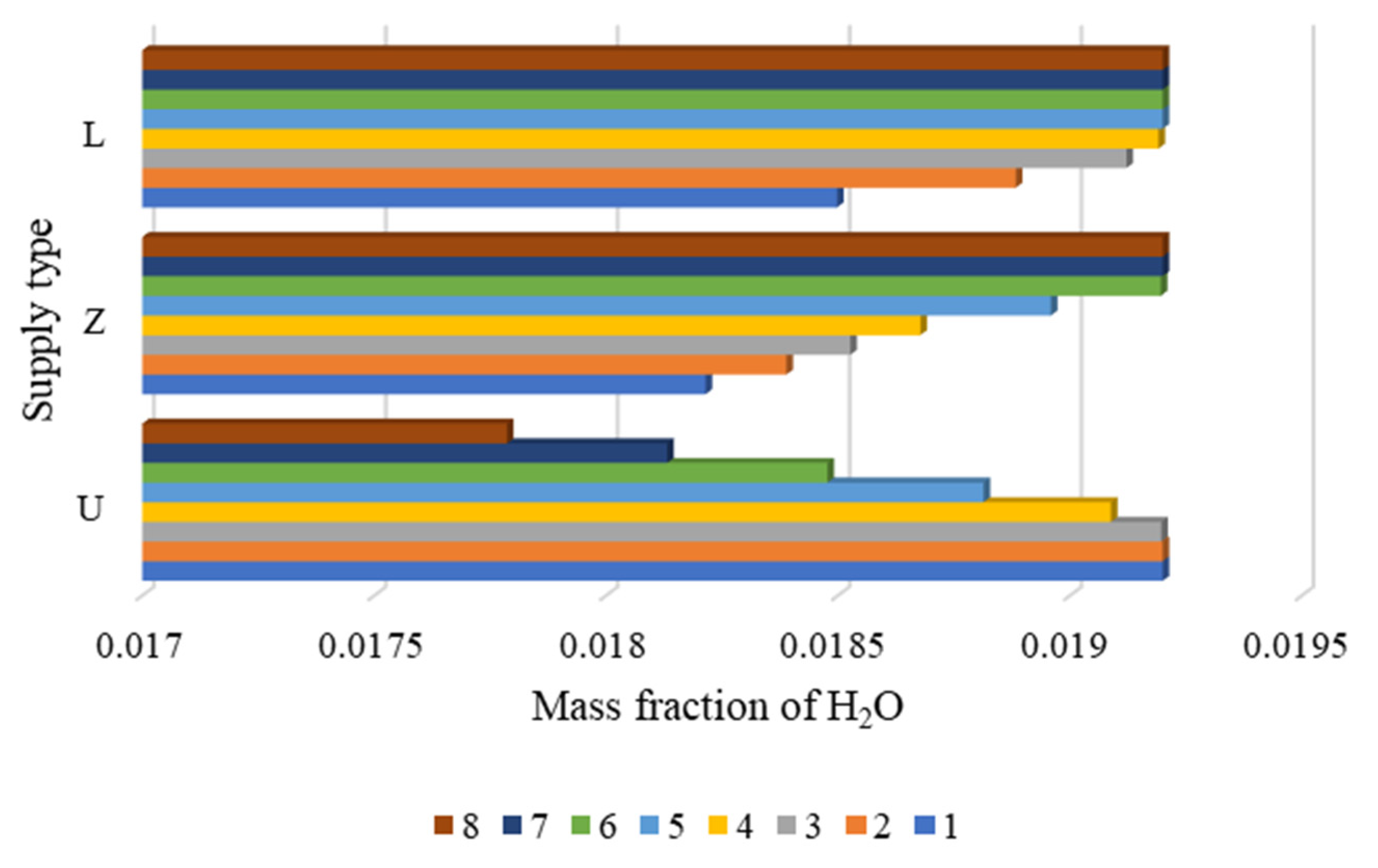

| Material | Thermal Conductivity (W·m−1·K−1) | Density (kg·m−3) | Specific Heat (J·kg−1·K−1) | Absolute Viscosity (kg·m−1·s−1) |
|---|---|---|---|---|
| Pipe (PVC) | 0.16 | 1380 | 900 | / |
| Soil | 2.1 | 1800 | 1780 | / |
| Air | 0.0242 | 1.225 | 1006.43 | 1.7894 × 10−5 |
| Boundary Conditions | Setup | Values [31] |
|---|---|---|
| Inlet | Velocity-inlet | / |
| Outlet | Pressure-outlet | / |
| Upper surface of soil | Wall | 297.49 K |
| Far-field soil | Wall | 291.85 K |
| Diameter of Parallel Pipes (mm) | Heat Transfer Rate (W) | Pressure Drop (Pa) | The Integrated Evaluation Factor η |
|---|---|---|---|
| 75 | 512.8 | 6842.7 | 19.9 |
| 90 | 549.7 | 2875.1 | 27.0 |
| 110 | 568.2 | 1128.9 | 35.8 |
| Type | Z-Type | U-Type | L-Type |
|---|---|---|---|
| Structure |  |  |  |
| Heat transfer rate (W) | 542.6 | 568.2 | 576.7 |
| Pressure drop (Pa) | 1474.9 | 1128.9 | 123.5 |
| η | 31.1 | 35.8 | 77.2 |
Publisher’s Note: MDPI stays neutral with regard to jurisdictional claims in published maps and institutional affiliations. |
© 2021 by the authors. Licensee MDPI, Basel, Switzerland. This article is an open access article distributed under the terms and conditions of the Creative Commons Attribution (CC BY) license (http://creativecommons.org/licenses/by/4.0/).
Share and Cite
Qi, D.; Zhao, C.; Li, S.; Chen, R.; Li, A. Numerical Assessment of Earth to Air Heat Exchanger with Variable Humidity Conditions in Greenhouses. Energies 2021, 14, 1368. https://doi.org/10.3390/en14051368
Qi D, Zhao C, Li S, Chen R, Li A. Numerical Assessment of Earth to Air Heat Exchanger with Variable Humidity Conditions in Greenhouses. Energies. 2021; 14(5):1368. https://doi.org/10.3390/en14051368
Chicago/Turabian StyleQi, Di, Chuangyao Zhao, Shixiong Li, Ran Chen, and Angui Li. 2021. "Numerical Assessment of Earth to Air Heat Exchanger with Variable Humidity Conditions in Greenhouses" Energies 14, no. 5: 1368. https://doi.org/10.3390/en14051368






